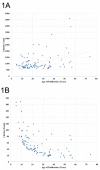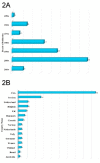The Top 100 Most Cited Articles Published in Dentistry: 2020 Update
- PMID: 33801013
- PMCID: PMC8003932
- DOI: 10.3390/healthcare9030356
The Top 100 Most Cited Articles Published in Dentistry: 2020 Update
Abstract
This bibliometric review is aimed to analyze the top 100 most-cited publications in dentistry and to compare its outcomes. A literature search was performed using Elsevier's Scopus, without any restriction of language, publication year, or study design. Of 336,381 articles, the top 100 were included based on their citation count, which ranged from 638 to 4728 citations (Feijoo et al., 326 to 2050). The most productive decade was the 2000s, with 40 articles on the list (Feijoo et al., 1980s: 26). Marx RE (7%) was the major contributor in this study (Feijoo et al., Socransky SS: 9%), and almost half (48%) of articles were from the USA. Of the top 100 articles, 26% focused on periodontology (Feijoo et al., periodontology: 43%), while 17% of the total were published in the Journal of Dental Research (Feijoo et al., Journal of Clinical Periodontology: 20%). Most of the publications were narrative reviews/expert opinion (36%), (Feijoo et al., case series: 22%), and were within the evidence level V (64%) (Feijoo et al., 54%). The citation count that a paper secures is not necessarily a reflection of research's quality, however, the current analysis provides the latest citation trends in dentistry.
Keywords: bibliometric analysis; citation analysis; dentistry; most cited.
Conflict of interest statement
The authors declare no conflict of interest.
Figures



Similar articles
-
The 100 most cited articles in dentistry.Clin Oral Investig. 2014 Apr;18(3):699-706. doi: 10.1007/s00784-013-1017-0. Epub 2013 Jun 15. Clin Oral Investig. 2014. PMID: 23771182
-
Applications of Bone Morphogenetic Proteins in Dentistry: A Bibliometric Analysis.Biomed Res Int. 2020 Oct 24;2020:5971268. doi: 10.1155/2020/5971268. eCollection 2020. Biomed Res Int. 2020. PMID: 33163536 Free PMC article. Review.
-
A bibliometric analysis of Periodontology 2000.Periodontol 2000. 2020 Feb;82(1):286-297. doi: 10.1111/prd.12328. Periodontol 2000. 2020. PMID: 31850637
-
Systemic Manifestations of the Periodontal Disease: A Bibliometric Review.Molecules. 2020 Oct 1;25(19):4508. doi: 10.3390/molecules25194508. Molecules. 2020. PMID: 33019648 Free PMC article. Review.
-
Top-Cited Articles in Implant Dentistry.Int J Oral Maxillofac Implants. 2017 May/Jun;32(3):555-564. doi: 10.11607/jomi.5331. Int J Oral Maxillofac Implants. 2017. PMID: 28494039
Cited by
-
Bibliometric Analysis of the Current Landscape of Global Scientific Production on the Development of Vaccines against Dental Caries.Int J Dent. 2022 May 2;2022:7678891. doi: 10.1155/2022/7678891. eCollection 2022. Int J Dent. 2022. PMID: 35547398 Free PMC article.
-
Bibliometric Analysis of the 100 Most-Cited Articles on Periodontics in the Arab World.Cureus. 2023 Sep 21;15(9):e45734. doi: 10.7759/cureus.45734. eCollection 2023 Sep. Cureus. 2023. PMID: 37745745 Free PMC article. Review.
-
Effects of Photobiomodulation on Oral Mucositis: Visualization and Analysis of Knowledge.Life (Basel). 2022 Nov 21;12(11):1940. doi: 10.3390/life12111940. Life (Basel). 2022. PMID: 36431074 Free PMC article. Review.
-
A Bibliometric Analysis of the 100 Top-Cited Articles on Vertical Root Fractures.Cureus. 2024 Dec 7;16(12):e75300. doi: 10.7759/cureus.75300. eCollection 2024 Dec. Cureus. 2024. PMID: 39776737 Free PMC article. Review.
-
Scientometric evaluation of endodontic publications by Gulf Cooperation Council region in 21st century.Saudi Dent J. 2022 Feb;34(2):107-113. doi: 10.1016/j.sdentj.2021.12.003. Epub 2021 Dec 14. Saudi Dent J. 2022. PMID: 35241899 Free PMC article.
References
-
- Olk P., Griffith T.L. Creating and disseminating knowledge among organizational scholars: The role of special issues. Organ. Sci. 2004;15:120–129. doi: 10.1287/orsc.1030.0055. - DOI
-
- Ring M.E. The world’s first dental journal. Compend. Contin. Educ. Dent. 1986;7:648–650. - PubMed
-
- Raja M., Ravichandran T. Recognizing self-citations via citation quality analysis. J. Theor. Appl. Inf. Technol. 2014;69:113–126.
LinkOut - more resources
Full Text Sources
Other Literature Sources

